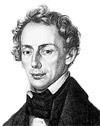A brief history of LiDAR
Find out who discovered LiDAR and how.
The oldest known variation of modern LiDAR systems evolved in nature millions of years ago. Chiroptera, more commonly known as the bat, uses an echolocation guidance system now known as SONAR (SOund Navigation And Ranging). They emit short, loud 'chirps' from their noses and receive an echo through their ears in the form of two antennae. This provides the bat with a three-dimensional view of the surrounding area, allowing them to avoid obstacles and easily find their prey.

Christian Huelsmeyer's Telemobiloscope
Humans started to develop similar systems in the beginning of the 20th century. Christian Huelsmeyer's "Telemobiloscope", developed in 1904, was the first form of RADAR (RAdio Detection And Ranging) sensor. This used radio waves outside the audible range. It consisted of an antenna, a receiver and a transmitter. Its original use was to detect metallic objects, in particular ships at sea, as a form of collision avoidance. This early form of RADAR had a distance of 3000m, much less than today's modern alternatives. On the detection of an object it would sound a bell until the object left its path.
The method of determining distance was later solved by aiming the beam at any level of elevation. Taking into account the height of the transmitting antenna and the angle of vertical elevation of the detected object allowed simple calculation to determine the distance of the object from the transmitter. RADARs transmit a narrow, rectangular shaped pulse modulating in a sine wave carrier. Distance is measured by the time it takes the pulse to travel to and from the target. It is also possible to use a continuous waveform showing the Doppler frequency shift to measure the targets velocity.
The Doppler Effect
Did you know?
The Doppler Effect explains why the sound of an approaching race car changes as it passes you.

Christian Doppler
The Doppler effect is named after Christian Andreas Doppler (1803-1853). Doppler was an Austrian mathematician and physicist. He was born in Salzburg, Austria, the son of a stone mason. After completing high school Doppler studied astronomy and mathematics in Vienna and Salzburg and started work at the Prague Polytechnic. At the age of 39 Doppler published his most famous work, "Über das farbige Licht der Doppelsterne und einiger anderer Gestirne des Himmels" (On the coloured light of the binary stars and some other stars of the heavens). In this works Doppler suggested his principle that the observed frequency of a wave depends on the relative speed of the source and the observer. He tried to use this theory for explaining the colours of binary stars.
LiDAR (Light Detection And Ranging) sensors work on the same principle as RADAR, firing a wavelength at an object and timing the delay in its return to the source to measure the distance between the two points. Because laser light has a much shorter wavelength it is possible to accurately measure much smaller objects, such as aerosols and cloud particles, which makes it especially suitable for airborne terrain mapping.
LiDAR (also known as LaDAR ot Laser Detection And Ranging) has been used extensively for atmospheric research and meteorology due to its excellent resolution. It was only with the deployment of Global Positioning Systems (GPS) in the 1980s, allowing the precise positioning of aircraft, that made airborne LiDAR surveying possible. Since then many downward looking LiDAR instruments have been developed for aircraft and satellite use.
For more information on the Doppler Effect view the Wikipedia article.
